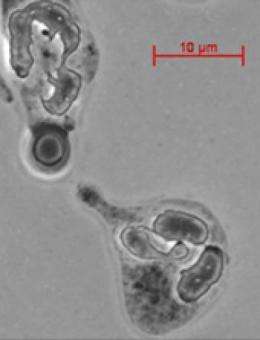This image shows two human neutrophils. The circular object about to be engulfed by the upper neutrophil is a Cryptococcus neoformans cell. Credit: Albert Einstein College of Medicine
In a study published in The Journal of Infectious Diseases, researchers from Albert Einstein College of Medicine of Yeshiva University have identified cells in blood that predict which HIV-positive individuals are most likely to develop deadly fungal meningitis, a major cause of HIV-related death. This form of meningitis affects more than 900,000 HIV-infected people globally—most of them in sub-Saharan Africa and other areas of the world where antiretroviral therapy for HIV is not available.
A major cause of fungal meningitis is Cryptococcus neoformans, a yeast-like fungus commonly found in soil and in bird droppings. Virtually everyone has been infected with Cryptococcus neoformans, but a healthy immune system keeps the infection from ever causing disease.
The risk of developing fungal meningitis from Cryptococcus neoformans rises dramatically when people have weakened immunity, due to HIV infection or other reasons including the use of immunosuppressive drugs after organ transplantation, or for treating autoimmune diseases or cancer. Knowing which patients are most likely to develop fungal meningitis would allow costly drugs for preventing fungal disease to be targeted to those most in need. (In the U.S., the widespread use of antiretroviral therapy by HIV-infected people, and their preventive use of anti-fungal drugs, has dramatically reduced their rate of fungal meningitis from Cryptococcus neoformans to about 2%.)
In this study, Liise-anne Pirofski, M.D., describes a technique for predicting which HIV-infected patients are at greatest risk for developing fungal meningitis caused by Cryptococcus neoformans. Dr. Pirofski is chief in the division of infectious diseases at Einstein.
Dr. Pirofski and her colleagues counted the number of immune cells known as IgM memory B cells in the bloodstream of three groups of individuals: people infected with HIV who had a history of fungal meningitis caused by Cryptococcus neoformans; people infected with HIV but with no history of the disease; and those with no history of either HIV infection or the disease.
"We were astounded to find a profound difference in the level of these IgM memory B cells between the HIV-infected groups," said Dr. Pirofski. "The HIV-infected people with fungal meningitis caused by Cryptococcus neoformans had much lower levels of these cells."
The research team wanted to know if the lower levels of IgM memory B cells in certain HIV-infected individuals resulted from the fungal disease, or whether their reduced levels of these cells preceded their development of the disease.
To find out, Dr. Pirofski analyzed frozen blood samples taken from HIV-infected patients before they had developed fungal meningitis due to Cryptococcus neoformans. Years before these HIV-infected patients were diagnosed with meningitis, their blood had far fewer IgM memory B cells than HIV-infected patients who didn't come down with the disease. This suggests that some people are predisposed to develop fungal meningitis because they have low levels of IgM memory B cells that may be due to their genetic makeup.
These findings could be important for many other immunocompromised patients in addition to those infected with HIV. "We think that knowing whether transplant recipients or other patients taking immunosuppressive drugs have low numbers of IgM memory B cells could be useful in deciding which patients should receive antifungal drugs to prevent meningitis caused by Cryptococcus neoformans," says Dr. Pirofski.
Source: Albert Einstein College of Medicine (news : web)


















